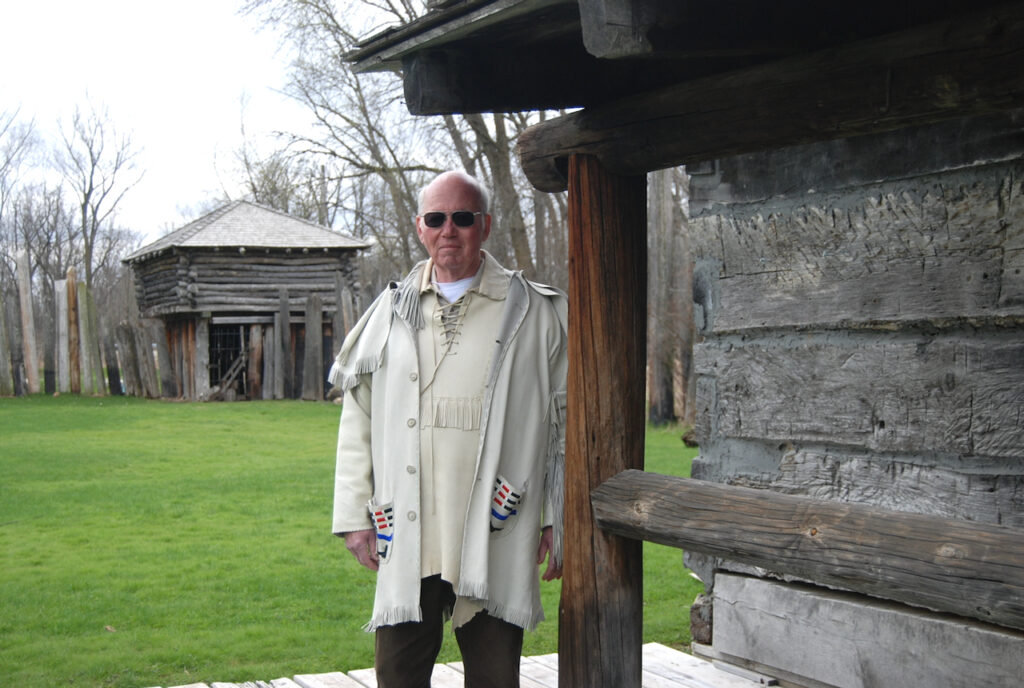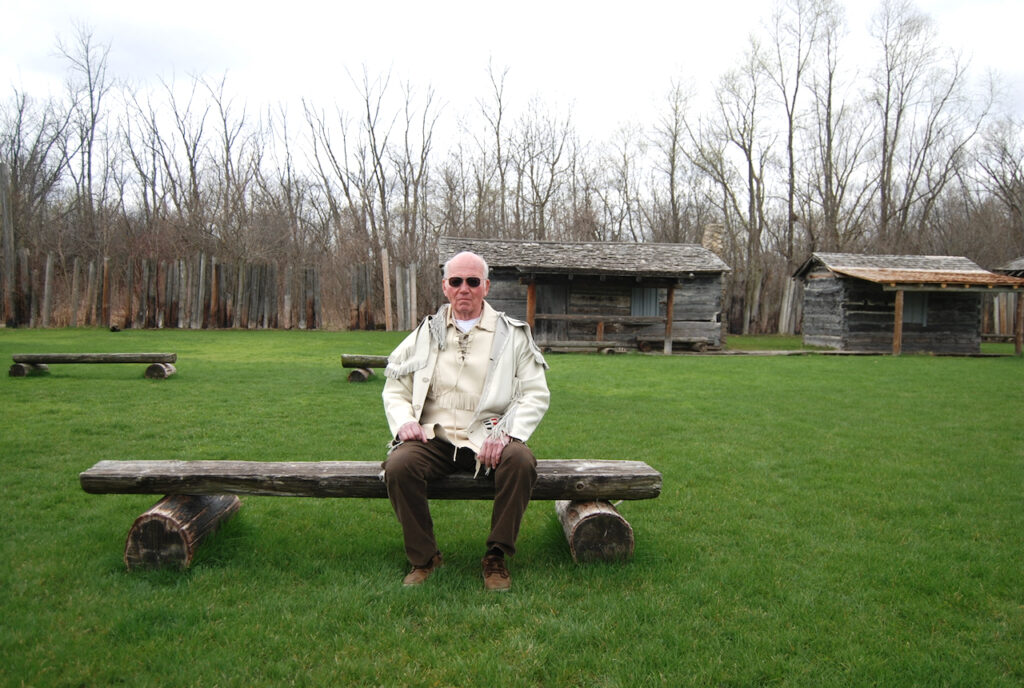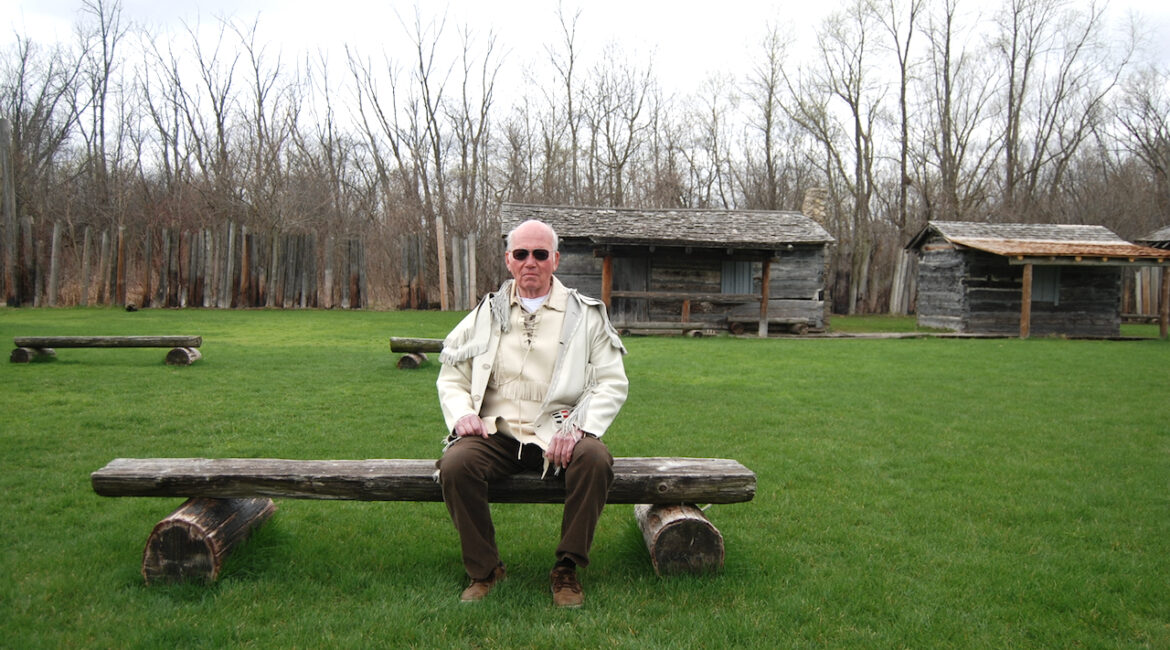By Kim McDarison
Fort Atkinson resident Joel Winn, dressed in a deerskin ensemble befitting an 1840s wilderness pioneer, surveyed the stockade replica in Fort Atkinson’s Rock River Park.
Earlier this week, some supplies had been delivered so that a portion of the enclosure’s entry could be rebuilt. It was just one of several activities underway in preparation of the return of the Fort Atkinson Rendezvous, which, Winn said, has been a tradition since 1994.
COVID-19 brought a pause to the annual event; it was suspended in 2020 and 2021, but Winn, known as the “booshway,” a title given by 1840s fur trappers and traders to the “head man” at an annual gathering, is ready to bring the event back to life.
He’s been calling the operation “Rendezvous Rescue,” he said, adding that this year’s theme is frontier medicine.
“The task is to renew interest in this and draw people back,” he added.
Winn noted that this year, Luke Acord, an individual from Minnesota, will be at the rendezvous, portraying a period-appropriate French surgeon.
In history, a rendezvous was typically held at the confluence of rivers. In the 1840s, in the wilds of America west of the Mississippi, rivers served the trappers and traders as a means of conveyance: they traveled by waterway in search of beaver pelts, a commodity used in the making of felt hats, which were fashionable at the time in Europe. Annually, they would arrive at a predetermined location to sell their pelts, and acquire supplies, after which they would return to the wilderness for another year of trapping.
Rendezvous were peaceful events that also provided a week of socializing and merriment, Winn said.
The rendezvous would last for only a short time and then the trappers and traders would go back into the wilderness in pursuit of beaver. They hunted their prize from the Rocky Mountains to California, Winn added.
As booshway of the Fort Atkinson Rendezvous, Winn said, he’s basically in charge of the two-day event, which, during Memorial Day weekend, overtakes the Rock River Park. There’s camping on the north end, while the south end, including the stockade replica, serves as a sort of emersion experience, where people come in costume and participate in activities that would likely have taken place during an actual rendezvous held in the 1800s.
“When we hold the event, we ask people to appear in period costume and there are some very talented people who can demonstrate those things that were common occurrences in everyday life.”
On the Friday before Memorial Day weekend, the exhibition traditionally has been open to and attended by fourth- and fifth-grade classes from about a 50-mile radius, he said.
A participant since the beginning, and booshway for more years than he can honestly remember, Winn said, the event is fun.
“You lose track of time when you’re having fun,” he said.
“It’s affordable and educational. If you’re not going to something Memorial Day weekend, here’s something in our own backyard that’s affordable for a family to take part in,” he said.
As booshway, he lays out the camp and plans for the event’s activities and demonstrations, which include such things as black powder shooting and axe and knife throwing competitions, flint fire starting, archery and blacksmithing.
There are apple peeling contests, won by creating the longest continuous strip, and pie baking backoffs.
People who camp often participate for the full two-day weekend. They can use the showers at the aquatic center.
In past years, the event has been visited by some 3,000 people, Winn said.
The War of 1832 and Gold Rush of 1849
As Winn described the Fort Atkinson Rendezvous, he recounted some pieces of history: the War of 1832 and the Gold Rush of 1849.
In 1832, he said, General Henry Atkinson and his soldiers found themselves in what is today the Fort Atkinson area.
It was the time of the Black Hawk War, Winn said. Black Hawk was a Sauk warrior who was leading his people through Wisconsin to lands from which they had earlier been displaced to make room for European settlers. As the Sauk people moved, the settlers became worried and formed militias, according to information on the Wisconsin Historical Society’s website.
It was against this backdrop that Atkinson and his men arrived and made a stockade for protection. They stayed for approximately five days and then they found Black Hawk’s trail heading west, Winn said.
To this day, the exact location of the stockade is not known, he said, but it was thought to be a three-sided structure built with its fourth side against the Rock River.
“General Atkinson and his army moved on to the Battle at Bad Axe. That did not take place here,” Winn said.
The Battle of Bad Axe, which history identifies as the final battle of the Black Hawk War, was fought between the Indians and the U.S. Army regulars and militia near present-day Victory in Vernon County.
Winn next segued to a different piece of American history.
At around the same period, America was undergoing exploration brought about by a European desire for beaver pelts, Winn said.
Harvesting beaver pelts was a source from which exploration of North American began, he said, adding: “The product was in demand and part of the American economy like nothing else.”
Said Winn: “Beaver trappers and traders tracked the beaver across the continent to the Rocky Mountains.
“These trappers and traders got together once a year and exchanged furs for goods that they needed to survive.”
When European manufacturers began making hats out of silk, the demand for fur began to diminish, he said.
“The trappers and traders were forced to look for other forms of work,” Winn said, adding that many of them found it serving as guides for those headed west to take part in the California Gold Rush of 1849.
Trappers were a good choice for that work because they understood the terrain and were familiar with changes in the weather, he said.
For anybody trying to get from St. Louis to California, they were an asset, he added.
A stockade replica in Fort
While historically, a fur trappers’ rendezvous was unlikely to have ever been hosted in Fort Atkinson, in the 1990s, Winn said, some community leaders believed the rendezvous concept could help modern-day residents of Fort Atkinson learn about a real event in history, and it could make use of the stockade replica, which, Winn said, was a project begun by a resident named Gus Klatt.
“He was a member of the Lions Club and employee with We Energies, and he spearheaded a project aimed at building a fort replica.
“He had access to old utility poles, which made for good fort-building material,” Winn said.
In 1960, a group of volunteers took old utility poles and erected a three-sided fort.
“The thought was to make a duplication of what was built in 1832,” Winn continued.
Rock River Park was chosen as a good spot because it had been determined that the park was in a flood plain.
“The city determined building the replica there made sense,” Winn said.
From replica to rendezvous
The idea to hold a rendezvous originated as a Chamber of Commerce Project LEAD group project, Winn said.
“The Project LEAD group borrowed the idea from another community. It was meant to be symbolic of what occurred in the 1840s in America, and primarily in the west,” he said, adding, “the concept of a representative history appealed to the founders of the rendezvous because there was no history to visit in terms of a military encounter with Black Hawk and his people. So an option was to visit a rendezvous similar to what took place in other places.
“Communities like Sauk City, Hartford, they were doing rendezvous.”
“From 1994 to today, we have maintained the structure and it becomes the host to this event each Memorial Day weekend,” he said.
A man of history
“I have a degree in history,” Winn said, noting that in 1994, he happened upon the event by chance.
“I went to the park and saw what was going on there and came home and changed my clothes and came back with weapons and artifacts, and my wife said, ‘If you buy a teepee you might as well join the tribe and keep on going.’
“I attended it and it immediately appealed to me to be a part of it, and over the course of time, I collected clothing and artifacts that were common to pioneer life on the (American) frontier,” Winn said, adding that his wife, Linda, is also a regular participant, bringing along a camera and lemonade.
People are invited to attend the rendezvous in wardrobe fitting for the time, which, Winn said, is open to each person’s own interpretation.
For many years, while he attended similar events, he portrayed a wheelwright.
“It was my niche,” he said.
Admission to the event is $2 a day for school-aged children. The same price applies to children attending with school groups or as members of the public, and $5 for adults. Admission is charged each day.
Parking is free.
This year, Winn said, a committee of about 15 volunteers has stepped up to help with Rendezvous Rescue.
Much work and planning to be ready by Memorial Day is still ahead, and, he said, Fort Atkinson’s booshway is in.


Two photos above: Fort Atkinson Rendezvous Booshway Joel Winn visits the stockage replica in Fort Atkinson’s Rock River Park. After a two-year pause due to COVID-19, he and a committee of volunteers are working to bring the event, which was begun in 1994, back. The event is planned for Memorial Day weekend. Kim McDarison photos.
This post has already been read 4530 times!

Good for you Joel! Best wishes for a successful event.
A wonderful link to our past! Thank you for all who are participating . Good going Joel!
The “Fort” that is part of the city’s name was really nothing more than a storage depot. Atkinson had been chasing Blackhawk’s group nearly the full length of the Rock River. They ventured as Far East as the creek into Whitewater that joins the bark. Logistic supply issues were a problem as wagons could run the many swamp land areas. So Atkinson could only fight north if he prepositional supplies and that is why the Fort was just like a Fenske protecting goods; no blockhouses or interior residence type structures. There is some pretty good reasons to believe the actual Fort was east of the Bark, just over the current bridge, directly across from Haumerson’s pond. Another interesting fact is that all that it would have taken to prevent the Blackhawk War was to grant 20 acres at the junction of the Rock and Mississippi Rivers back to the tribe; it was their historic burial grounds and settlers were plowing it. Thousands of people died on both sides; most of the troops from Cholera.